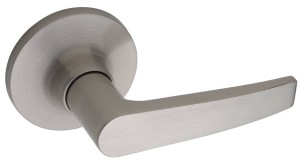 We’ve discussed the topic of hardware grades time and time again on LockBytes and with good reason – it’s incredibly important. Knowing your hardware grades can be the difference in saving large amounts of money over time and a reoccurring broken lever set. Thankfully, it’s one of the easiest issues to address when it comes to your locking hardware.
We’ve discussed the topic of hardware grades time and time again on LockBytes and with good reason – it’s incredibly important. Knowing your hardware grades can be the difference in saving large amounts of money over time and a reoccurring broken lever set. Thankfully, it’s one of the easiest issues to address when it comes to your locking hardware.
Hardware grades are a set of minimum performance standards that apply to products. These are developed by ANSI/BHMA and can also be used as a way to determine appropriate hardware application. Your hardware will always fall into one of these three grades:
- Grade 1 Hardware – Heavy-duty commercial usage
- Grade 2 Hardware – Light-duty commercial usage
- Grade 3 Hardware – Residential usage
Hardware Grades Explained
Grade determination is based on durability, application uses and lifecycle expectancy. The most important aspect is the application uses, which is the number of cycles, or “uses,” a product will withstand before needing replacement. As that stands, a Grade 1 is going to withstand a high cycle count to accommodate any heavy traffic that may pass through and a Grade 3 is going to have a much lower cycle count before it needs to be replaced.
Grade One Hardware
Grade one hardware, designed for heavy-duty commercial use, will hold up through the use and abuse of busy facilities, function properly and also keep your facility safe.
Of course, proper installation is key in hardware performing the way it was designed and intended. Performance issues throughout the entire lifetime of the door hardware are a possibility if there are underlying door issues or if the hardware was installed improperly. In order to achieve the best results, use a certified technician to install the properly graded hardware.
One more thing – it’s important to bear in mind that while the higher grade locks have a higher initial cost, the lifetime cost of the lock decreases as the grade increases.
Grade Two Hardware
When considering grade two hardware it’s important to remember it’s designed for light-duty commercial applications and that is entirely different from heavy-duty commercial applications. That seems really obvious but we’ve seen it time and time again – a grade two installed when a grade one is clearly warranted. If your facility sees over one hundred patrons a day, your hardware is being overworked.
That being said, there are plenty of facilities that are perfectly happy with grade two hardware, because they have a lighter traffic flow on a daily basis. However, all grade two locks are not created equal as the minimum standards set by ANSI/BHMA are just that – a minimum. Some will perform at the higher end of the cycle count while others will struggle to meet the threshold. Your best bet is to consult with the manufacturer or hardware specialist to determine the quality of the product in question. You may decide that a higher quality grade two or grade one lever set would be a better fit for your facility.
Grade Three Hardware
Grade three hardware is only built to withstand a low cycle count because it was specifically designed for residential usage. A door in the average family home isn’t getting nearly as much traffic as a door in the middle of a busy department store. Unfortunately, there are still facilities that think they can “swing it” with grade three hardware in a commercial setting, but they’re inevitably going to be replacing their hardware much sooner than if it were a higher grade. Not only will this waste valuable time but money as well.
All commercial facilities need to at least be using grade two hardware, and for some facilities even grade two isn’t enough and will need grade one hardware. The return on your initial investment will be clear in performance immediately and you will quickly realize you’re calling your locksmith or service provider a lot less frequently.
